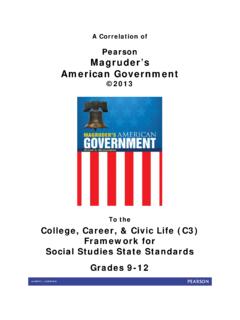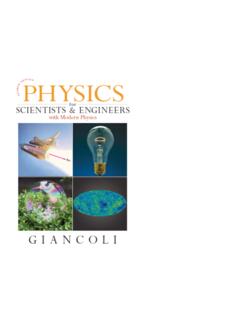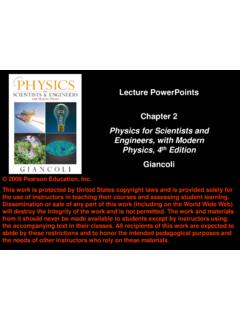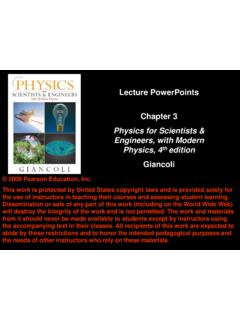Transcription of Third EdiTion physics - Pearson School
1 F O R S C I E N T I S T S A N D E N G I N E E R Sphysicsa strategic approachT h i r d E d i T i o nrandall d. knightCalifornia Polytechnic State UniversitySan Luis ObispoBoston Columbus Indianapolis New York San Francisco Upper Saddle RiverAmsterdam Cape Town Dubai London Madrid Milan Munich Paris Montreal TorontoDelhi Mexico City Sao Paulo Sydney Hong Kong Seoul Singapore Taipei TokyoWITH modern 110/18/11 9:54 AMPublisher: James SmithSenior Development Editor: Alice Houston, Project Editor: Martha SteeleAssistant Editor: Peter AlstonMedia Producer: Kelly ReedSenior Administrative Assistant: Cathy GlennDirector of Marketing: Christy LeskoExecutive Marketing Manager: Kerry McGinnisManaging Editor: Corinne BensonProduction Project Manager.
2 Beth CollinsProduction Management, Composition, and Interior Design: Cenveo Publisher Services/Nesbitt Graphics, : Rolin GraphicsCover Design: Yvo Riezebos DesignManufacturing Buyer: Jeff SargentPhoto Research: Eric SchraderImage Lead: Maya MelenchukCover Printer: Lehigh-PhoenixText Printer and Binder: Donnelley/WillardCover Image: Composite illustration by Yvo Riezebos DesignPhoto Credits: See page C-1 Library of Congress Cataloging-in-Publication DataKnight, Randall for scientists and engineers : a strategic approach / randall d. knight. -- 3rd ed. p. bibliographical references and 978-0-321-74090-81. physics --Textbooks. I. 2012530--dc232011033849 ISBN-13: 978-0-132-83212-0 ISBN-10: 0-132-83212-7 (High School binding)Copyright 2013, 2008, 2004 Pearson Education, Inc.
3 All rights reserved. Manufactured in the United States of America. This publication is protected by Copyright, and permission should be obtained from the publisher prior to any prohibited reproduction, storage in a retrieval system, or transmission in any form or by any means, electronic, mechanical, photocopying, recording, or likewise. To obtain permission(s) to use material from this work, please submit a written request to Pearson Education, Inc., Permissions Department, 1900 E. Lake Ave., Glenview, IL 60025. For information regarding permissions, call (847) of the designations used by manufacturers and sellers to distinguish their products are claimed as trademarks. Where those designations appear in this book, and the publisher was aware of a trademark claim, the designations have been printed in initial caps or all is a trademark, in the and/or other countries, of Pearson Education, Inc.
4 Or its 2 3 4 5 6 7 8 9 10 DOW 15 14 13 12 210/24/11 3:22 PMiiiBrief Contents Part I Newton s Laws Chapter 1 Concepts of Motion 2 Chapter 2 Kinematics in One Dimension 33 Chapter 3 Vectors and Coordinate Systems 69 Chapter 4 Kinematics in Two Dimensions 85 Chapter 5 Force and Motion 116 Chapter 6 Dynamics I: Motion Along a Line 138 Chapter 7 Newton s Third Law 167 Chapter 8 Dynamics II: Motion in a Plane 191 Part II Conservation Laws Chapter 9 Impulse and Momentum 220 Chapter 10 Energy 245 Chapter 11 Work 278 Part III Applications of Newtonian Mechanics Chapter 12 Rotation of a Rigid Body 312 Chapter 13 Newton s Theory of Gravity 354 Chapter 14 Oscillations 377 Chapter 15 Fluids and Elasticity 407 Part IV Thermodynamics Chapter 16 A Macroscopic Description of Matter 444 Chapter 17 Work,Heat.
5 And the First Law of Thermodynamics 469 Chapter 18 The Micro/Macro Connection 502 Chapter 19 Heat Engines and Refrigerators 526 Part V Waves and Optics Chapter 20 Traveling Waves 560 Chapter 21 Superposition 591 Chapter 22 Wave Optics 627 Chapter 23 Ray Optics 655 Chapter 24 Optical Instruments 694 Part VI Electricity and Magnetism Chapter 25 Electric Charges and Forces 720 Chapter 26 The Electric Field 750 Chapter 27 Gauss s Law 780 Chapter 28 The Electric Potential 810 Chapter 29 Potential and Field 839 Chapter 30 Current and Resistance 867 Chapter 31 Fundamentals of Circuits 891 Chapter 32 The Magnetic Field 921 Chapter 33 Electromagnetic Induction 962 Chapter 34 Electromagnetic Fields and Waves 1003 Chapter 35 AC Circuits 1033 Part VII Relativity and Quantum physics Chapter 36 Relativity 1060 Chapter 37 The Foundations of modern physics 1102 Chapter 38 Quantization 1125 Chapter 39 Wave Functions and Uncertainty 1156 Chapter 40 One-Dimensional Quantum Mechanics 1179 Chapter 41 Atomic physics 1216 Chapter 42 Nuclear physics 1248 Appendix A Mathematics Review A-1 Appendix B Periodic Table of Elements A-4 Appendix C Atomic and Nuclear Data A-5 Appendix D ActivPhysics OnLine Activities and PhET Simulations A-9 Answers to Odd-Numbered Problems A-11 310/21/11 4:16 PMWorked Examples walk the student carefully through detailed solutions, focusing on underlying reasoning and common pitfalls to avoid.
6 NEW! Data-based Examples (shown here) help students with the skill of drawing conclusions from laboratory c h a p t e r 4 . Kinematics in Two Dimensions Thus vt=vr and at=ar are analogous equations for the tangential velocity and acceleration. In Example , where we found the roulette ball to have angular acceleration a= rad/s2, its tangential acceleration was at=ar=( rad/s2)( m)= m/s2 eXAMPle Analyzing rotational data You ve been assigned the task of measuring the start-up charac-teristics of a large industrial motor. After several seconds, when the motor has reached full speed, you know that the angular ac-celeration will be zero, but you hypothesize that the angular ac-celeration may be constant during the first couple of seconds as the motor speed increases.
7 To find out, you attach a shaft encoder to the axle. A shaft encoder is a device that converts the angular position of a shaft or axle to a signal that can be read by a computer. After setting the computer program to read four values a second, you start the motor and acquire the following data: Time (s) Angle ( ) a. Do the data support your hypothesis of a constant angular ac-celeration? If so, what is the angular acceleration? If not, is the angular acceleration increasing or decreasing with time? b. A 76-cm-diameter blade is attached to the motor shaft. At what time does the acceleration of the tip of the blade reach 10 m/s2? MoDel The axle is rotating with nonuniform circular motion. Model the tip of the blade as a particle.
8 VIsUAlIZe FIGURe shows that the blade tip has both a tangen-tial and a radial acceleration. a=2m. If the graph is not a straight line, our observation of whether it curves upward or downward will tell us whether the angular acceleration us increasing or decreasing. FIGURe is the graph of u versus t2, and it confirms our hypothesis that the motor starts up with constant angular ac-celeration. The best-fit line, found using a spreadsheet, gives a slope of /s2. The units come not from the spreadsheet but by looking at the units of rise ( ) over run ( s2 because we re graphing t2 on the x -axis). Thus the angular acceleration is a=2m= /s2*p rad180 = rad/s2 where we used 180 =p rad to convert to SI units of rad/s2.
9 FIGURe Pictorial representation of the axle and blade. t2(s2)u ( ) line FIGURe Graph of u versus t2 for the motor shaft. solve a. If the motor starts up with constant angular acceleration, with ui=0 and vi=0 rad/s, the angle-time equation of rotational kinematics is u=12 at2. This can be written as a linear equation y=mx+b if we let u=y and t2=x. That is, constant angular acceleration predicts that a graph of u versus t2 should be a straight line with slope m=12 a and y -intercept b=0. We can test this. If the graph turns out to be a straight line with zero y -intercept, it will confirm the hypothesis of constant angular acceleration and we can then use its slope to determine the angular acceleration: b.
10 The magnitude of the linear acceleration is a=2ar 2+at 2 Constant angular acceleration implies constant tangential ac-celeration, and the tangential acceleration of the blade tip is at=ar=( rad/s2)( m)= m/s2 We were careful to use the blade s radius, not its diameter, and we kept an extra significant figure to avoid round-off error. The radial (centripetal) acceleration increases as the rotation speed increases, and the total acceleration reaches 10 m/s2 when ar=2a2-at 2=2(10 m/s2)2-( m/s2)2= m/s2 Radial acceleration is ar=v2r, so the corresponding angular velocity is v=Aarr= m= rad/s For constant angular acceleration, v=at, so this angular ve-locity is achieved at t=va= rad/s2= s Thus it takes s for the acceleration of the blade tip to reach 10 m/s2.










![Modern Physics [Phys207] - Missouri University of Science ...](/cache/preview/3/6/b/5/5/5/a/7/thumb-36b555a703faa2c10b5d9776ce7cbc27.jpg)








